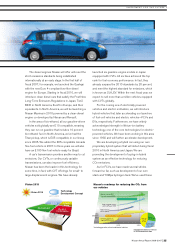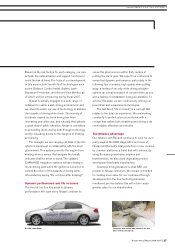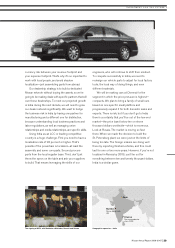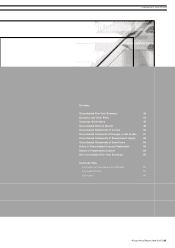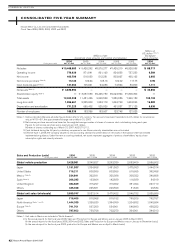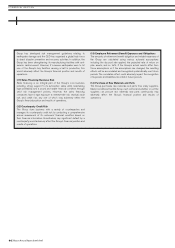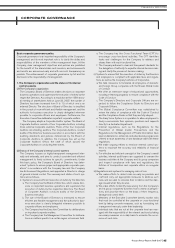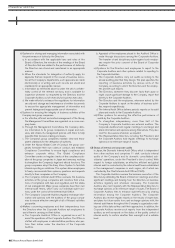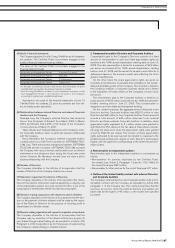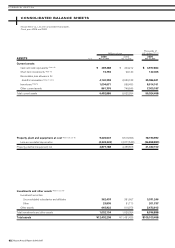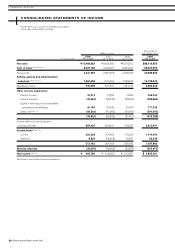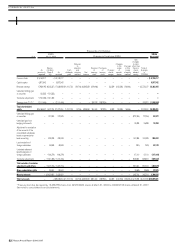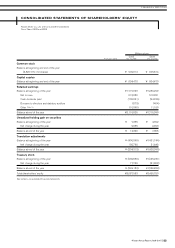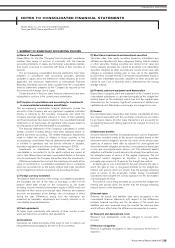Nissan 2007 Annual Report Download - page 47
Download and view the complete annual report
Please find page 47 of the 2007 Nissan annual report below. You can navigate through the pages in the report by either clicking on the pages listed below, or by using the keyword search tool below to find specific information within the annual report.
Basic corporate governance policy
Corporate governance is an important responsibility of the Company’s
management, and its most important role is to clarify the duties and
responsibilities of the members of the management team. At the
Company, clear management objectives and policies are published
for the benefit of the shareholders and investors, and achievements
and results are announced early and with as much transparency as
possible. The enhancement of corporate governance by full and fair
disclosure is the responsibility of management.
1. The Company’s organization and the status of its internal
control systems
(1) The Company’s organization
The Company’s Board of Directors makes decisions on important
business operations and supervises the execution of duties by the
respective Directors. According to a resolution at the 108th annu-
al meeting of shareholders held on June 20, 2007, the number of
Directors has been increased from 9 to 10, of which one is an
external Director. The structure of Board of Directors is simplified
in the pursuit of more efficient and flexible management, and the
authority for business execution is clearly delegated wherever
possible to corporate officers and employees. Furthermore, the
Executive Committee deliberates important corporate matters.
The Company adopts a Corporate Auditor system. The Board of
Corporate Auditors consists of four Corporate Auditors, including
three external Corporate Auditors. Three of the four Corporate
Auditors are standing auditors. The Corporate Auditors conduct
audits of the Directors’ business execution in accordance with the
auditing standards and policies determined by the Board of
Corporate Auditors. In addition, the Company has set up the
Corporate Auditors’ Office, the staff of which assists the
Corporate Auditors in conducting their duties.
(2) Status of the Company’s internal control systems
The Company focuses on highly transparent management inter-
nally and externally, and aims to conduct consistent and efficient
management to firmly achieve its specific commitments. Under
this basic policy, the Company’s Board of Directors has deter-
mined “systems to ensure proper and appropriate corporate oper-
ations” in accordance with the Company law and the Company
law Enforcement Regulations, and appointed a Director in charge
of general internal control. The summary and status of such sys-
tems are as follows.
i) Systems to ensure efficient execution of duties by the Directors
a. The Company has the Board of Directors, which makes deci-
sions on important business operations and supervises the
execution of duties by the respective Directors. The Board
of Corporate Auditors conducts audits of the Directors’
business execution.
b. The size of the Board of Directors is minimized to ensure
efficient and flexible management, and the authority for busi-
ness execution is clearly delegated wherever possible to
corporate officers and employees.
c. The Company has the Executive Committee for deliberations
on important corporate matters.
d. The Company has the Management Committee for delibera-
tions on matters specific to a certain region or business field.
e. The Company has the Cross Functional Team (CFT) to
encourage cross-functional activities. The CFT identifies
tasks and challenges for the Company to address and
shares them with each functional line.
f. The Company adheres to clear and transparent standards for
the delegation of authority to expedite internal decision mak-
ing and clarify the process of decision making.
ii) Systems to ensure that the execution of duties by the Directors
and employees is compliant with applicable laws and regula-
tions, as well as the Company’s Articles of Corporation.
a. We take measures to familiarize all employees of domestic
and foreign Group companies with the Nissan Global Code
of Conduct.
b. We offer an extensive range of educational opportunities,
including e-learning programs to ensure compliance with the
Code of Conduct.
c. The Company’s Directors and Corporate Officers are ex-
pected to follow the Compliance Guide for Directors and
Corporate Officers.
d. The Global Compliance Committee was established to
review the status of compliance with the Code of Conduct
and the Compliance Guide so that they are fully obeyed.
e. The Easy Voice System is in operation to allow employees to
freely communicate their opinions, questions and requests
directly to a dedicated department.
f. Internal regulations, such as the Regulations for the
Prevention of Global Insider Transactions and the
Regulations for the Management of Private Information, have
been established or enhanced, and educational programs are
offered to raise awareness of and familiarize staff with these
regulations.
g. We make ongoing efforts to reinforce internal control sys-
tems to maximize the accuracy and reliability of financial
reports.
h. For effective and efficient oversight of the Company’s overall
activities, internal audit teams are organized to oversee the
business activities at the Company and its group companies
and inspect compliance with laws and regulations, the
Articles of Incorporation and corporate ethics on a regular
basis.
iii)Regulations and systems for managing risks of loss
a. We make efforts to detect risks as early as possible and
craft and carry out appropriate measures to address such
risks, and we seek to minimize their incidence and the dam-
age caused when they do arise.
b. We make efforts to identify risks arising from the Company’s
and its group companies’ activities from a variety of perspec-
tives, and prioritize them on the basis of their frequency,
damage and control level.
c. Members of the Executive Committee directly monitor risks
that must be controlled at the corporate or cross-functional
level by taking concrete measures, such as formulating risk
management manuals, under their leadership.
d. Individual risks that are not at the corporate level are man-
aged with the responsibility of the relevant sections by taking
necessary measures on a daily basis to minimize the occur-
rence of such risks.
CORPORATE GOVERNANCE
Nissan Annual Report 2006-2007 45
FINANCIAL SECTION»


